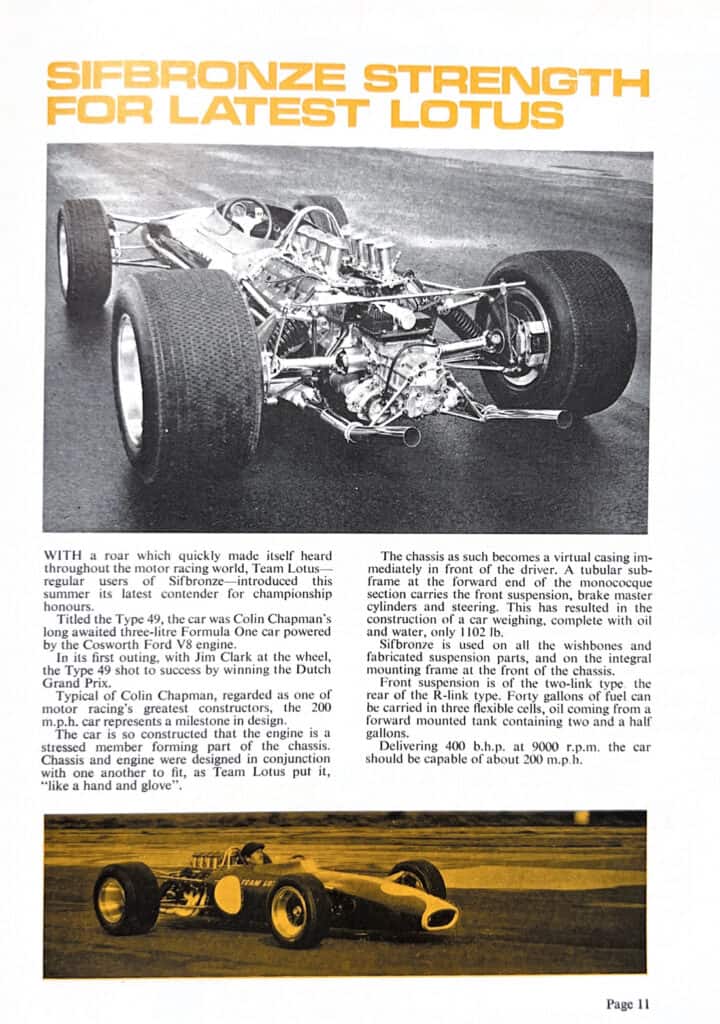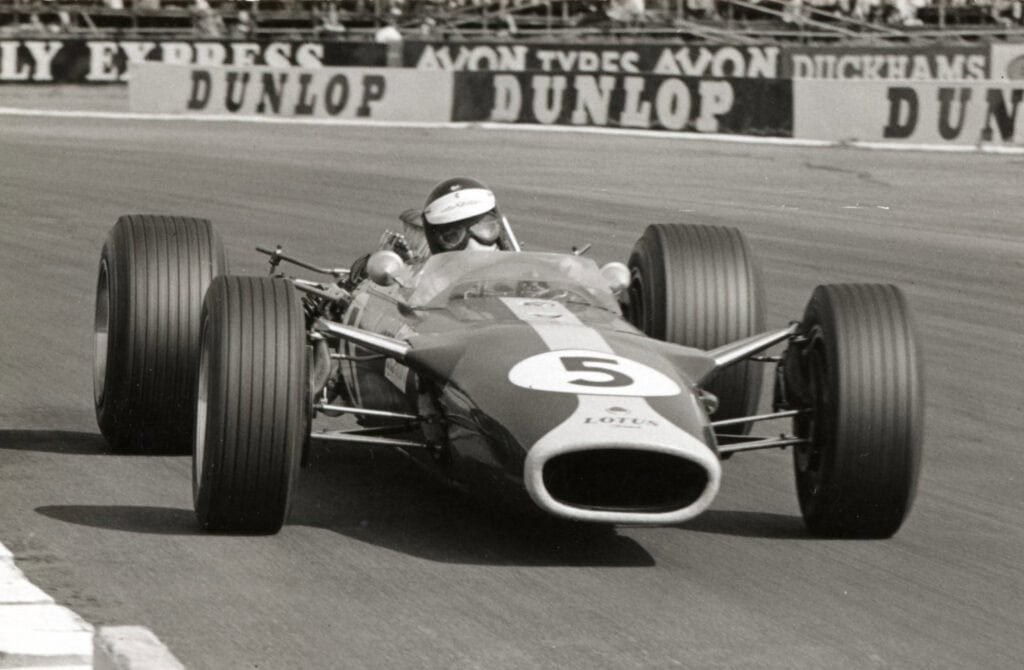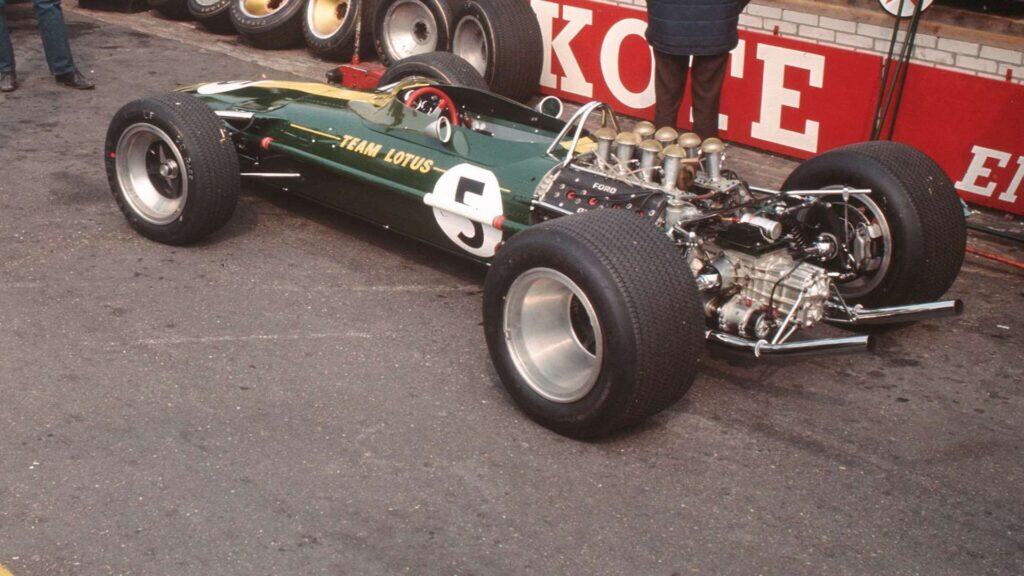Introduction
The Lotus Type 49, introduced in 1967, marked a significant leap in Formula 1 engineering. Designed by Colin Chapman and powered by the Ford-Cosworth DFV V8 engine, the car revolutionized race car design by making the engine a stressed member of the chassis. This case study examines the crucial role of Sifbronze in the construction and success of the Lotus Type 49.

Design and Engineering
The Lotus Type 49 was designed to be lightweight and highly efficient. Key features included:
- Engine as Stressed Member: The DFV engine was integrated as a structural component, enhancing rigidity and reducing weight.
- Monocoque Chassis: The car featured a monocoque chassis with a tubular subframe at the front, housing the suspension and steering components.
- Sifbronze Welding: Sifbronze was used extensively in the construction of the Type 49, particularly on the wishbones, fabricated suspension parts, and the integral mounting frame at the front of the chassis. This welding technique provided strength and reliability, essential for the car’s high-performance demands.
Performance and Achievements
The Lotus Type 49 quickly proved its prowess on the track:
- Debut and Victory: Jim Clark won the Dutch Grand Prix in the Type 49’s first race, demonstrating the car’s superior design and engineering.
- Speed and Power: The DFV engine delivered 400 bhp at 9,000 rpm, propelling the car to speeds of around 200 mph. The car weighed just 1,102 lbs, including oil and water, contributing to its agility and speed.
- Championships: The Type 49 helped Lotus secure two Constructors’ Championships (1968, 1970) and two Drivers’ Championships (1968 for Graham Hill and 1970 for Jochen Rindt).
Technical Specifications
- Engine: 3.0-liter Ford-Cosworth DFV V8
- Power Output: 400 bhp at 9,000 rpm
- Top Speed: Approximately 200 mph
- Weight: 1,102 lbs
- Fuel Capacity: 40 gallons in three flexible cells
- Oil Capacity: 2.5 gallons from a forward-mounted tank
Impact and Legacy
The Lotus Type 49’s innovative use of the engine as a stressed member set a new standard in Formula 1 car design. The success of the Type 49, highlighted by its impressive performance stats and championship wins, solidified Lotus’s reputation as a leader in race car engineering.
Press Coverage
The introduction of the Type 49 was widely covered in the press, with attention drawn to its groundbreaking design and immediate success. Publications highlighted the car’s technical innovations and the impressive achievements of Team Lotus and its drivers.
Conclusion
The Lotus Type 49 is remembered not only for its victories on the track but also for its engineering excellence. Sifbronze played a pivotal role in the construction of the Type 49, ensuring the strength and reliability of its critical components. This combination of innovative design and advanced materials contributed to the car’s lasting legacy in the world of motorsport.
For further details, you can refer to sources like Formula1.com and Wikipedia (Wikipedia) (G503).
https://media.lotuscars.com/en/heritage-race-cars/lotus-type-49.html




- References –
- Lotus Type 49 – https://classicteamlotus.co.uk/en/news/posts/2016/all-the-lotus-49s-together,-for-the-first-time-ever/
- First Time Out (Lotus 49) – 1967 – https://www.youtube.com/watch?v=V6cm3eWEHM0
- Graham Hill testing the “Lotus 49” Formula One Car in 1967 – https://www.youtube.com/watch?v=gWNesl4P83Y
- Lotus 49 Cosworth – https://www.goodwood.com/grr/race/historic/lotus-49-and-cosworth-dfv-delight-and-drama-in-1967/
- Team Lotus Image – https://www.goodwood.com/grr/race/historic/lotus-49-and-cosworth-dfv-delight-and-drama-in-196
- 1967 German Grand Prix – https://primotipo.com/tag/1967-german-grand-prix/
- Article Links –
- Lotus 49 Cosworth Article – https://www.f1technical.net/f1db/cars/220/lotus-49
- Lotus 49: Revolutionary car with era-defining engine – https://www.motorsportmagazine.com/archive/article/april-2024/130/lotus-49-race-car-of-the-century-shortlist/
